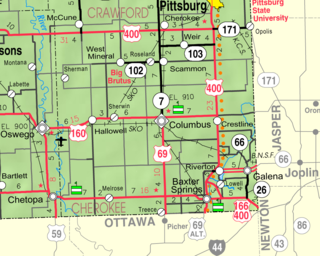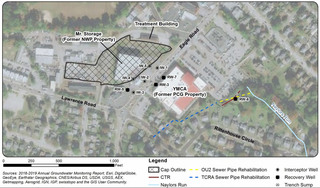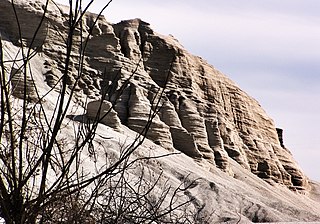
The Summitville mine was a gold mining site in the United States, located in Rio Grande County, Colorado 25 miles (40 km) south of Del Norte. It is remembered for the environmental damage caused in the 1980s by the leakage of mining by-products into local waterways and then the Alamosa River.

Treece is a ghost town in Cherokee County, Kansas, United States, and part of the historic Tri-State Mining District. As of the 2010 census, the city population was 138. As of May 2012 the city was abandoned and most buildings and other facilities demolished due to pervasive problems with lead pollution resulting from past mining. Two people who had refused an Environmental Protection Agency (EPA) buyout remained in 2012, then one died in 2016.

ASARCO is a mining, smelting, and refining company based in Tucson, Arizona, which mines and processes primarily copper. The company has been a subsidiary of Grupo México since 1999.

The Berkeley Pit is a former open pit copper mine in the western United States, located in Butte, Montana. It is one mile (1.6 km) long by one-half mile (800 m) wide, with an approximate depth of 1,780 feet (540 m). It is filled to a depth of about 900 feet (270 m) with water that is heavily acidic, about the acidity of Coca-Cola, lemon juice, or gastric acid. As a result, the pit is laden with heavy metals and dangerous chemicals that leach from the rock, including copper, arsenic, cadmium, zinc, and sulfuric acid.

Gilman is an abandoned mining town in southeastern Eagle County, Colorado, United States. The U.S. Post Office at Minturn now serves Gilman postal addresses.

Naylors Run is a 4.6-mile-long (7.4 km) tributary of Cobbs Creek in Haverford and Upper Darby Township, Pennsylvania, United States.

Burke Canyon is the canyon of the Burke-Canyon Creek, which runs through the northernmost part of Shoshone County, Idaho, U.S., within the northeastern Silver Valley. A hotbed for mining in the late-nineteenth and twentieth centuries, Burke Canyon now contains several ghost towns and remnants of former communities along Idaho State Highway 4, which runs northeast through the narrow canyon to the Montana border.

Havertown Superfund is a 13-acre polluted groundwater site in Havertown, Pennsylvania contaminated by the dumping of industrial waste by National Wood Preservers from 1947 to 1991. The state first became aware of the pollution in 1962 and initiated legal action against the owners in 1973 to force them to cleanup the site. The Environmental Protection Agency (EPA) ranked the site the eighth worst cleanup project in the United States. The site was added to the National Priorities List in 1983 and designated as a Superfund cleanup site in the early 1990s. Remediation and monitoring efforts are ongoing and the EPA transferred control of the site to the Pennsylvania Department of Environmental Protection in 2013.

The Midnite Mine is an inactive uranium mine in the Selkirk Mountains of the state of Washington that operated from 1955 to 1965 and again from 1968 to 1981. Located within the reservation of the Spokane Tribe of Indians, it is approximately 8 miles (13 km) from Wellpinit, Stevens County. The mine was listed as a Superfund site under the Comprehensive Environmental Response, Compensation, and Liability Act of 1980 (CERCLA) on May 11, 2000. In addition to elevated levels of radioactivity, heavy metals mobilized in uranium acid mine drainage pose a potential threat to human health and the environment.

Tar Creek Superfund site is a United States Superfund site, declared in 1983, located in the cities of Picher, Douthat and Cardin, Ottawa County, in northeastern Oklahoma. From 1900 to the 1960s lead mining and zinc mining companies left behind huge open chat piles that were heavily contaminated by these metals, cadmium, and others. Metals from the mining waste leached into the soil, and seeped into groundwater, ponds, and lakes. Because of the contamination, Picher children have suffered elevated lead, zinc and manganese levels, resulting in learning disabilities and a variety of other health problems. The EPA declared Picher to be one of the most toxic areas in the United States.

In the 1950s, the Navajo Nation was situated directly in the uranium mining belt that experienced a boom in production, and many residents found work in the mines. Prior to 1962, the risks of lung cancer due to uranium mining were unknown to the workers, and the lack of a word for radiation in the Navajo language left the miners unaware of the associated health hazards. The cultural significance of water for the Navajo people and the environmental damage to both the land and livestock inhibits the ability of the Navajo people to practice their culture.

Leviathan Mine is a United States superfund site at an abandoned open-pit sulfur mine located in Alpine County, California. The mine is located on the eastern slope of the Sierra Nevada at about 7,000-foot (2,100 m) elevation, 6 miles (9.7 km) east of Markleeville and 24 miles (39 km) southeast of Lake Tahoe. The mine site comprises approximately 250 acres (100 ha) of land surrounded by the Toiyabe National Forest, which is only accessible a few months a year. The approximately 22 million tons of sulfur ore-containing crushed rock at the mine are responsible for contaminating the Leviathan and Aspen Creek, which join with Mountaineer Creek to form Bryant Creek which ultimately empties into the East Fork of the Carson River. These water bodies are listed as 303(d) impaired. The site location is seismically active.
Rimini, is a ghost town in Lewis and Clark County, Montana, United States. It is one of the oldest mining districts in the state. It was established when silver lodes were discovered in 1864. Other names for the town were Lewis and Clark, Tenmile, Vaughn, Colorado, and Bear Gulch. It was the site of Camp Rimini.

Silver Bow Creek is a 26-mile-long (42 km) headwater stream of the Clark Fork (river) originating within the city limits of Butte, Montana, from the confluence of Little Basin and Blacktail Creeks. A former northern tributary, Yankee Doodle Creek, no longer flows directly into Silver Bow Creek as it is now captured by the Berkeley Pit. Silver Bow Creek flows northwest and north through a high mountain valley, passing east of Anaconda, Montana, where it becomes the Clark Fork at the confluence with Warm Springs Creek.

The California Gulch site consists of approximately 18 square miles in Lake County, Colorado. The area includes the city of Leadville, parts of the Leadville Historic Mining District and a section of the Arkansas River from the confluence of California Gulch downstream to the confluence of Two-Bit Gulch. The site was listed as a Superfund site in 1983.

The 2015 Gold King Mine waste water spill was an environmental disaster that began at the Gold King Mine near Silverton, Colorado, when Environmental Protection Agency (EPA) personnel, along with workers for Environmental Restoration LLC, caused the release of toxic waste water into the Animas River watershed. They caused the accident by breaching a tailings dam while attempting to drain ponded water near the entrance of the mine on August 5. After the spill, the Silverton Board of Trustees and the San Juan County Commission approved a joint resolution seeking Superfund money.
According to a survey completed by the Colorado Geological Survey between 1991 and 1999, the number of abandoned mines in Colorado is 18,382. The Arkansas Headwaters, Las Animas River, Rio Grande Headwaters, Alamosa, and Uncompahgre were the priority watersheds studied in this survey. In the survey, analysis was completed with Environmental Degradation Measures ranging from none to extreme. Results showed 26 abandoned mines with extreme degradation and mineral hazards, 219 with significant degradation, and 672 potentially significant hazards.
The Lava Cap Mine is an abandoned gold mine in Nevada County, California. The mine is located 5 miles (8.0 km) southeast of Nevada City. The site is undergoing cleanup by the United States Environmental Protection Agency for arsenic contamination.














